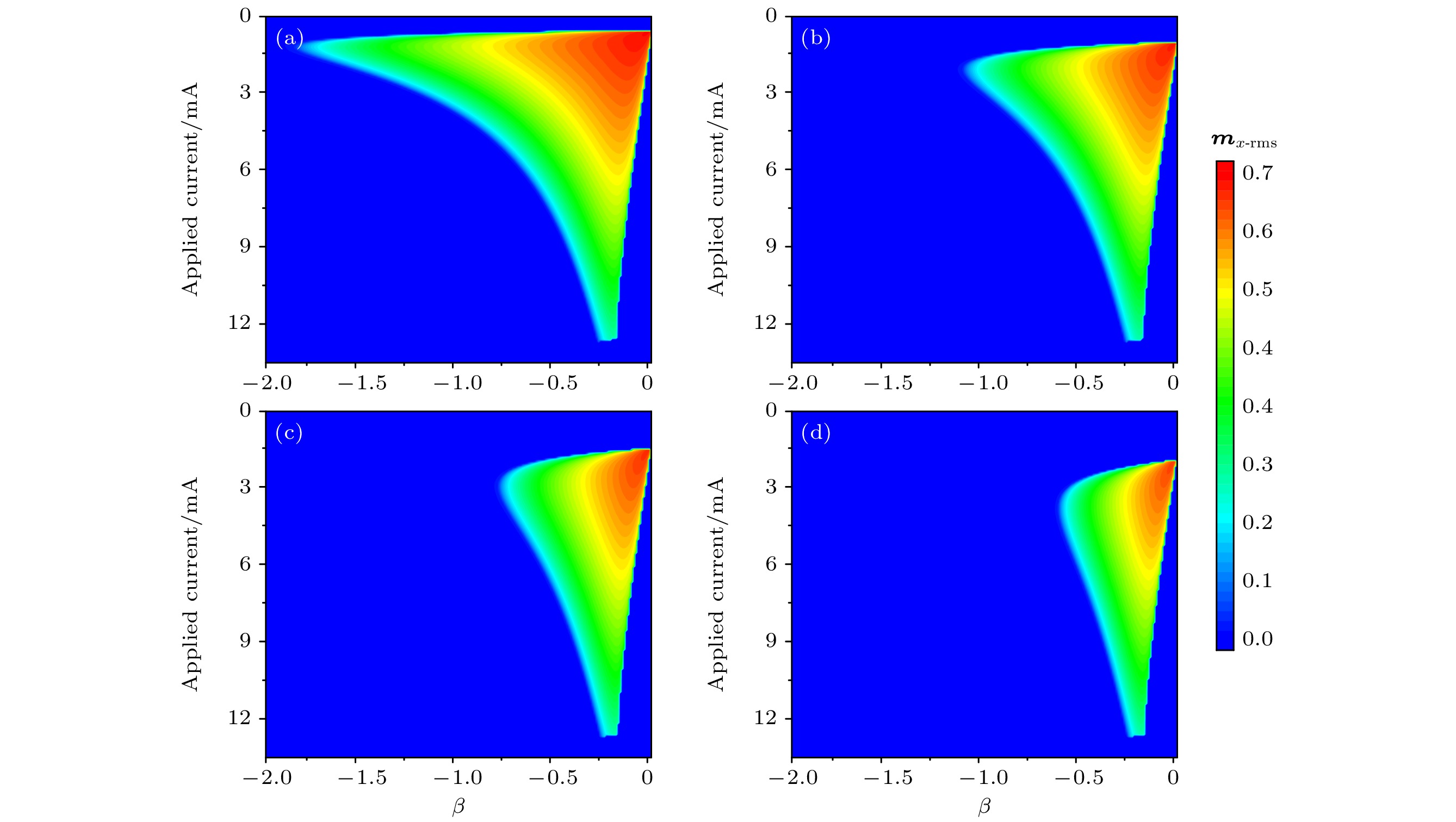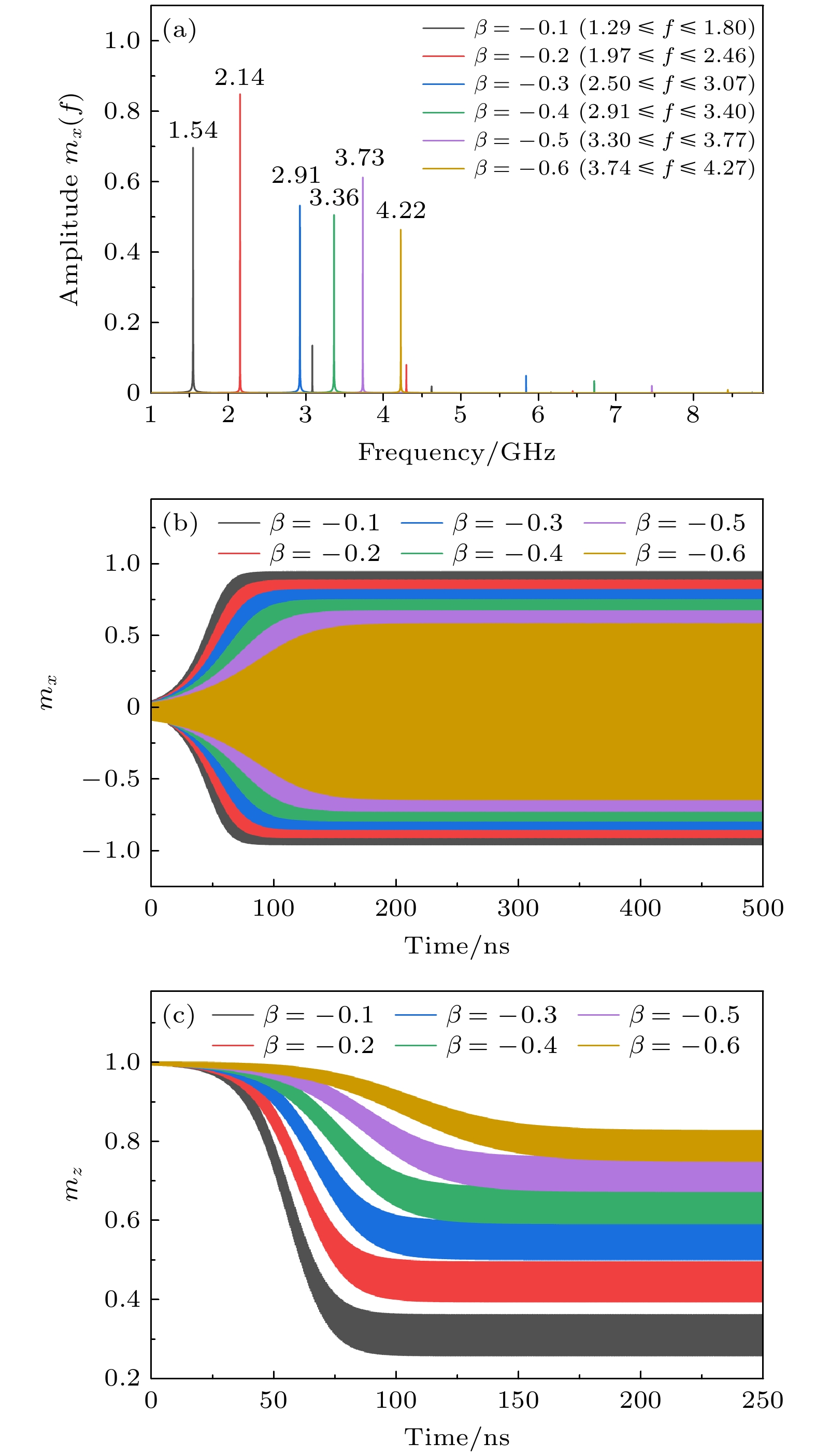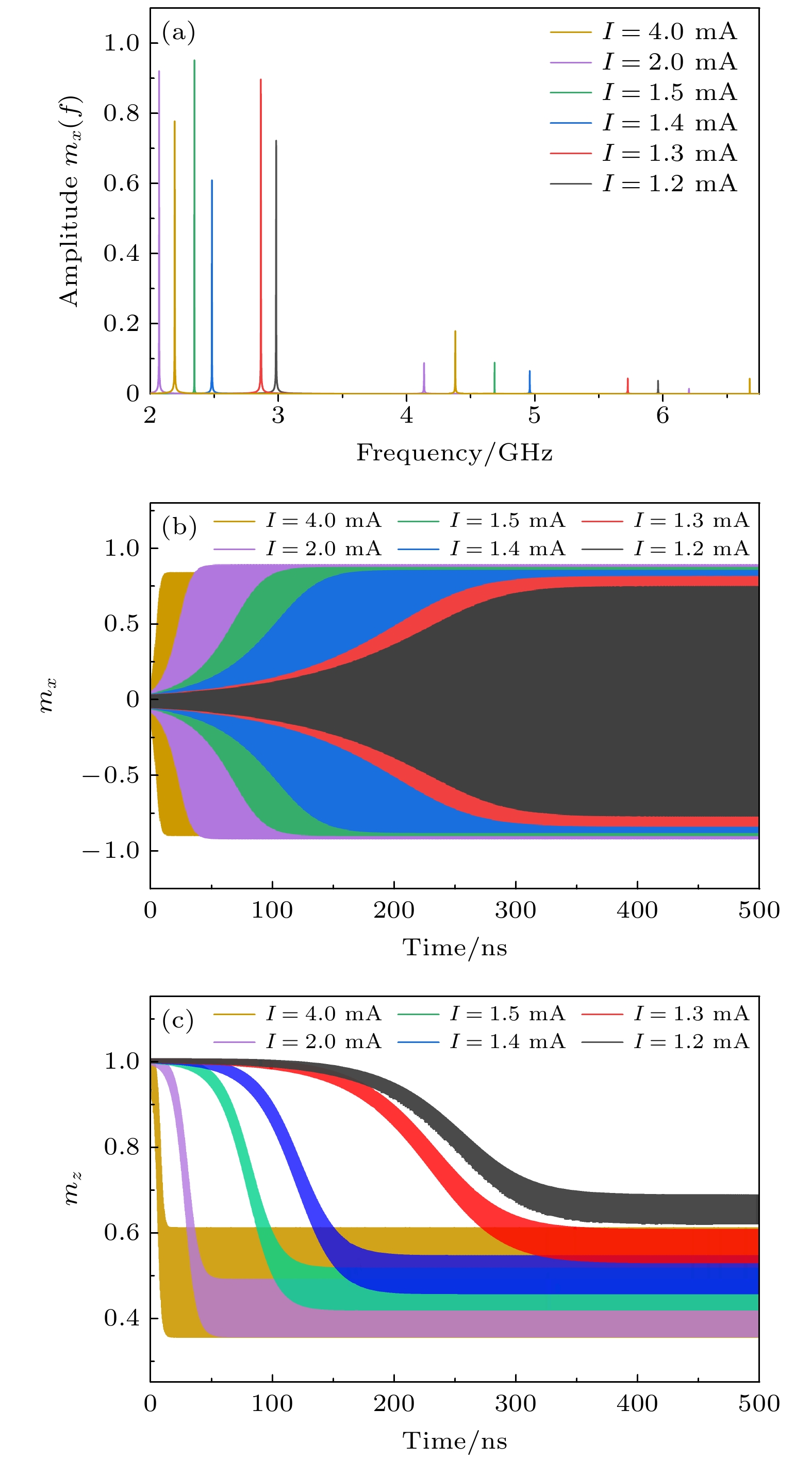-
自旋转移力矩纳米振荡器是一种直流驱动的新型纳米微波振荡器, 因其易集成、尺寸小、频率调制范围宽等优点, 成为未来射频收发器的理想器件. 但是, 自旋转移力矩纳米振荡器的稳定自激振荡需要外加磁场的条件限制了其应用. 基于宏自旋模型(又称单自旋或单畴模型), 利用Landau-Lifshitz-Gilbert-Slonczewski方程, 理论上研究了类场矩和电流强度对垂直磁化的自由层磁矩的零场稳定自激振荡特性的影响. 研究结果表明, 当类场矩参数与自旋转移力矩参数的比值为负值且其绝对值大于某一数值时, 自旋转移力矩纳米振荡器可以实现零场自激振荡, 其物理机制可以通过能量平衡方程解释, 并且这一临界比值依赖于该系统的阻尼系数和电流强度. 尤其是, 自旋转移力矩纳米振荡器的稳定自激振荡频率可以通过类场矩参数与自旋转移力矩参数的比值和电流强度的大小来调节, 并且其类场矩的绝对值越大, 施加的电流强度越小(大于临界电流强度), 则越有利于抑制二次和三次自激振荡频率的形成, 从而提高自旋转移力矩纳米振荡器的“单频”性. 上述结果提供了一种实现频率可调的零场自旋转移力矩纳米振荡器的理论方案.
-
关键词:
- 自旋转移力矩纳米振荡器 /
- 类场矩 /
- 零场稳定振荡
The spin-torque nano-oscillator (STNO), which is a novel type of nano-sized microwave oscillator driven by direct current, is considered as a promising candidate for future radio frequency (RF) transceivers owing to its scalability, nanoscale size and high frequency tunability. However, the potential application of STNO is limited because its stable oscillation requires an external magnetic field. In this work, the influences of the field-like torque and applied current intensity on the stable oscillation of STNO with a perpendicularly magnetized free layer are studied theoretically based on the macrospin model (also known as the single-spin or single-domain model) and the Landau-Lifshitz-Gilbert-Slonczewski (LLGS) equation in the absence of magnetic field. It is demonstrated numerically that a stable oscillation of STNO can be observed when the ratio between the field-like torque and the spin torque is a negative value and larger than a certain value that depends on the damping coefficient and the current intensity, whose physical mechanism can be understood by the energy balance equation. Moreover, the frequency of stable oscillation of STNO can be modulated by the ratio between the field-like torque and the spin torque and also by the current intensity. Particularly, the larger the absolute value of the ratio between the field-like torque and the spin torque and the smaller the applied current intensity (above the critical current intensity), the more conducive it is to suppressing the formation of second and third oscillation frequencies, thereby enhancing the STNO’s “single-frequency” feature. Our findings provide a theoretical scheme for realizing a frequency tunable zero-field STNO, which may be useful for designing future RF transceivers.[1] Slonczewski J C 1996 J. Magn. Magn. Mater. 159 L1
 Google Scholar
Google Scholar
[2] Berger L 1996 Phys. Rev. B 54 9353
 Google Scholar
Google Scholar
[3] Julliere M 1975 Phys. Lett. A 54 225
 Google Scholar
Google Scholar
[4] Miyazaki T, Tezuka N 1995 J. Magn. Magn. Mater. 139 L231
 Google Scholar
Google Scholar
[5] Moodera J S, Kinder L R, Wong T M, Meservey R 1995 Phys. Rev. Lett. 74 3273
 Google Scholar
Google Scholar
[6] Kiselev S I, Sankey J C, Krivorotov I N, Emley N C, Schoelkopf R J, Buhrman R A, Ralph D C 2003 Nature 425 380
 Google Scholar
Google Scholar
[7] Houssameddine D, Ebels U, Delaet B, Rodmacq B, Firastrau I, Ponthenier F, Brunet M, Thirion C, Michel J P, Prejbeanu-Buda L, Cyrille M C, Redon O, Dieny B 2007 Nat. Mater. 6 447
 Google Scholar
Google Scholar
[8] Georges B, Grollier J, Cros V, Fert A 2008 Appl. Phys. Lett. 92 232504
 Google Scholar
Google Scholar
[9] Ranjbar M, Drrenfeld P, Haidar M, Iacocca E, Balinskiy M, Le T Q, Fazlali M, Houshang A, Awad A A, Dumas R K, Kerman J 2014 IEEE Magn. Lett. 5 3000504
 Google Scholar
Google Scholar
[10] Kubota H, Yakushiji K, Fukushima A, Tamaru S, Konoto M, Nozaki T, Ishibashi S, Saruya T, Yuasa S, Taniguchi T, Arai H, Imamura H 2013 Appl. Phys. Express 6 103003
 Google Scholar
Google Scholar
[11] Litvinenko A, Iurchuk V, Sethi P, Louis S, Tyberkevych V, Li J, Jenkins A, Ferreira R, Dieny B, Slavin A, Ebels U 2020 Nano Lett. 20 6104
 Google Scholar
Google Scholar
[12] 方彬, 曾中明 2014 科学通报 59 1804
 Google Scholar
Google Scholar
Fang B, Zeng Z M 2014 Chin. Sci. Bull. 59 1804
 Google Scholar
Google Scholar
[13] Taniguchi T, Arai H, Tsunegi S, Tamaru S, Kubota H, Imamura H 2013 Appl. Phys. Express 6 123003
 Google Scholar
Google Scholar
[14] Awad A A, Houshang A, Zahedinejad M, Khymyn R, Åkerman J 2020 Appl. Phys. Lett. 116 232401
 Google Scholar
Google Scholar
[15] Arun R, Gopal R, Chandrasekar V K, Lakshmanan M 2022 J. Phys. Condens. Matter 34 125803
 Google Scholar
Google Scholar
[16] Taniguchi T, Tsunegi S, Kubota H, Imamura H 2014 Appl. Phys. Lett. 104 152411
 Google Scholar
Google Scholar
[17] Taniguchi T, Arai H, Kubota H, Imamura H 2014 IEEE Trans. Magn. 50 1400404
 Google Scholar
Google Scholar
[18] Guo Y Y, Xue H B, Liu Z J 2015 AIP Adv. 5 057114
 Google Scholar
Google Scholar
[19] Arun R, Gopal R, Chandrasekar V K, Lakshmanan M 2022 J. Appl. Phys. 132 094301
 Google Scholar
Google Scholar
[20] Arai H, Matsumoto R, Yuasa S, Imamura H 2015 Appl. Phys. Express 8 083005
 Google Scholar
Google Scholar
[21] Arai H, Matsumoto R, Yuasa S, Imamura H 2016 J. Phys. Soc. Jpn. 85 063802
 Google Scholar
Google Scholar
[22] Guo Y Y, Zhao F F, Xue H B, Liu Z J 2016 Chin. Phys. Lett. 33 037501
 Google Scholar
Google Scholar
[23] Zhao C P, Ma X Q, Huang H B, Liu Z H, Jafri H M, Wang J J, Wang X Y, Chen L Q 2017 Appl. Phys. Lett. 111 082406
 Google Scholar
Google Scholar
[24] 郭圆圆, 蒿建龙, 薛海斌, 刘喆颉 2015 64 198502
 Google Scholar
Google Scholar
Guo Y Y, Hao J L, Xue H B, Liu Z J 2015 Acta Phys. Sin. 64 198502
 Google Scholar
Google Scholar
[25] Kowalska E, Kákay A, Fowley C, Sluka V, Lindner J, Fassbender J, Deac A M 2019 J. Appl. Phys. 125 083902
 Google Scholar
Google Scholar
[26] Shirokura T, Hai P N 2020 J. Appl. Phys. 127 103904
 Google Scholar
Google Scholar
[27] Zhang W, Zhang Y, Jiang B, Fang B, Zhong H, Li H, Zeng Z M, Yan S S, Han G, Liu G, Yu S, Kang S 2021 Appl. Phys. Lett. 118 012405
 Google Scholar
Google Scholar
[28] Slonczewski J C 1989 Phys. Rev. B 39 6995
 Google Scholar
Google Scholar
[29] Slonczewski J C 2005 Phys. Rev. B 71 024411
 Google Scholar
Google Scholar
[30] Fowley C, Sluka V, Berent K, Lindner J, Fassbender J, Rippard W H, Pufall M R, Russek S E, Deac A M 2014 Appl. Phys. Express 7 043001
 Google Scholar
Google Scholar
[31] Taniguchi T, Kubota H 2016 Phys. Rev. B 93 174401
 Google Scholar
Google Scholar
[32] Taniguchi T, Ito T, Tsunegi S, Kubota H, Utsumi Y 2017 Phys. Rev. B 96 024406
 Google Scholar
Google Scholar
[33] Taniguchi T, Isogami S, Shiokawa Y, Ishitani Y, Komura E, Sasaki T, Mitani S, Hayashi M 2022 Phys. Rev. B 106 104431
 Google Scholar
Google Scholar
[34] Mancilla-Almonacid D, Arias R E, Escobar R A, Altbir D, Allende S 2018 J. Appl. Phys. 124 162102
 Google Scholar
Google Scholar
[35] Talatchian P, Romera M, Araujo F A, Bortolotti P, Cros V, Vodenicarevic D, Locatelli N, Querlioz D, Grollier J 2020 Phys. Rev. Appl. 13 024073
 Google Scholar
Google Scholar
[36] Zeng L, Xu X J, Chen H H, Zhou Y, Zhang D M, Wang Y J, Zhang Y G, Zhao W S 2020 Appl. Phys. Lett. 117 082404
 Google Scholar
Google Scholar
[37] Kaka S, Pufall M R, Rippard W H, Silva T J, Russek S E, Katine J A 2005 Nature 437 389
 Google Scholar
Google Scholar
[38] Mancoff F B, Rizzo N D, Engel B N, Tehrani S 2005 Nature 437 393
 Google Scholar
Google Scholar
[39] Singh H, Konishi K, Bhuktare S, Bose A, Miwa S, Fukushima A, Yakushiji K, Yuasa S, Kubota H, Suzuki Y, Tulapurkar A A 2017 Phys. Rev. Appl. 8 064011
 Google Scholar
Google Scholar
[40] Singh H, Bose A, Bhuktare S, Fukushima A, Yakushiji K, Yuasa S, Kubota H, Tulapurkar A A 2018 Phys. Rev. Appl. 10 024001
 Google Scholar
Google Scholar
[41] Zeng L, Liu Y, Chen H H, Zhou Y, Zhang D M, Zhang Y G, Zhao W S 2020 Nanotechnology 31 375205
 Google Scholar
Google Scholar
-
图 1 由三个圆形薄膜组成的自旋转移力矩纳米振荡器的示意图. 该结构上面为厚度d和截面半径r分别为2 nm和60 nm的自由层, 且其磁矩垂直于膜面; 中间为1 nm厚度非磁性材料形成的隧道势垒层; 下面为磁矩平行于膜面的极化层. 在笛卡尔坐标系中, x-y平面和z轴分别平行和垂直于膜面, 而在球坐标系中
$\varphi $ 和θ分别为自由层磁矩的方位角和极角Fig. 1. Schematic diagram for the considered spin-transfer torque nano-oscillator consisting of the trilayer circular thin films. Here, the top, middle and bottom layers are the 2 nm-thick perpendicular magnetized free layer with a radius of 60 nm, the 1 nm-thick tunnel barrier layer formed by non-magnetic material and the in-plane polarizer pinned layer, respectively. Moreover, in the Cartesian coordinate system, the x-y plane and z-axes of are parallel and perpendicular to the free layer, respectively; while the
$\varphi $ and θ in the spherical coordinate system are the azimuth and polar angles of the magnetization of the free layer, respectively.图 2 自由层磁矩
$x$ 轴分量${m_x}$ 的均方根${m_{x{\text{-rms}}}}$ 在不同阻尼系数下随β和I变化的相图 (a)$\alpha = 0.003$ ; (b)$\alpha = 0.005$ ; (c)$\alpha = 0.007$ ; (d)$\alpha = 0.009$ Fig. 2. Phase diagrams of the root-mean-square value of
${m_{x{\text{-rms}}}}$ of the${m_x}$ component of the free layer as a function of β and I with different Gilbert damping constants: (a)$\alpha = 0.003$ ; (b)$\alpha = 0.005$ ; (c)$\alpha = 0.007$ ; (d)$\alpha = 0.009$ 图 3 当电流为1.5 mA时, 在一个周期内, 自旋转移力矩提供的平均能量
${\overline W_{\text{s}}}$ , 阻尼消耗的平均能量${\overline W_\alpha }$ , 以及其平均能量之差${\overline W_{\text{s}}} - {\overline W_\alpha }$ 随自由层磁矩z分量的变化 (a) β = 0; (b) β = –0.2; (c) β = 0.2Fig. 3. In a precession period, the average work done by the spin-transfer torque
${\overline W_{\text{s}}}$ , the average energy dissipation due to the damping${\overline W_\alpha }$ , and the energy difference between${\overline W_{\text{s}}}$ and${\overline W_\alpha }$ as a function of the z component of the free layer magnetization at given current intensity I = 1.5 Ma: (a) β = 0; (b) β = –0.2; (c) β = 0.2.图 4 (a) 自旋转移力矩纳米振荡器的振幅和频率对β的依赖关系; (b), (c) 自由层磁矩的x分量和z分量在不同类场矩β情形下的稳态振荡情况(I = 1.5 mA)
Fig. 4. (a) Dependences of the amplitude and frequency of spin-transfer torque nano-oscillator on the β; (b), (c) the x and the z components of the free layer magnetization as a function of time for the different ratios between the spin-tranfer torque and the field-like torque β (I = 1.5 mA).
图 6 (a)自旋转移力矩纳米振荡器的振幅和频率对施加电流强度I的依赖关系; (b), (c) 自由层磁矩的x分量和z分量在不同电流强度情形下的稳态振荡情况(β = –0.2)
Fig. 6. (a) Dependences of the amplitude and frequency of spin-transfer torque nano-oscillator on the applied current intensity I; (b), (c) the x and the z components of the free layer magnetization as a function of time for the different values of current intensity (β = –0.2).
-
[1] Slonczewski J C 1996 J. Magn. Magn. Mater. 159 L1
 Google Scholar
Google Scholar
[2] Berger L 1996 Phys. Rev. B 54 9353
 Google Scholar
Google Scholar
[3] Julliere M 1975 Phys. Lett. A 54 225
 Google Scholar
Google Scholar
[4] Miyazaki T, Tezuka N 1995 J. Magn. Magn. Mater. 139 L231
 Google Scholar
Google Scholar
[5] Moodera J S, Kinder L R, Wong T M, Meservey R 1995 Phys. Rev. Lett. 74 3273
 Google Scholar
Google Scholar
[6] Kiselev S I, Sankey J C, Krivorotov I N, Emley N C, Schoelkopf R J, Buhrman R A, Ralph D C 2003 Nature 425 380
 Google Scholar
Google Scholar
[7] Houssameddine D, Ebels U, Delaet B, Rodmacq B, Firastrau I, Ponthenier F, Brunet M, Thirion C, Michel J P, Prejbeanu-Buda L, Cyrille M C, Redon O, Dieny B 2007 Nat. Mater. 6 447
 Google Scholar
Google Scholar
[8] Georges B, Grollier J, Cros V, Fert A 2008 Appl. Phys. Lett. 92 232504
 Google Scholar
Google Scholar
[9] Ranjbar M, Drrenfeld P, Haidar M, Iacocca E, Balinskiy M, Le T Q, Fazlali M, Houshang A, Awad A A, Dumas R K, Kerman J 2014 IEEE Magn. Lett. 5 3000504
 Google Scholar
Google Scholar
[10] Kubota H, Yakushiji K, Fukushima A, Tamaru S, Konoto M, Nozaki T, Ishibashi S, Saruya T, Yuasa S, Taniguchi T, Arai H, Imamura H 2013 Appl. Phys. Express 6 103003
 Google Scholar
Google Scholar
[11] Litvinenko A, Iurchuk V, Sethi P, Louis S, Tyberkevych V, Li J, Jenkins A, Ferreira R, Dieny B, Slavin A, Ebels U 2020 Nano Lett. 20 6104
 Google Scholar
Google Scholar
[12] 方彬, 曾中明 2014 科学通报 59 1804
 Google Scholar
Google Scholar
Fang B, Zeng Z M 2014 Chin. Sci. Bull. 59 1804
 Google Scholar
Google Scholar
[13] Taniguchi T, Arai H, Tsunegi S, Tamaru S, Kubota H, Imamura H 2013 Appl. Phys. Express 6 123003
 Google Scholar
Google Scholar
[14] Awad A A, Houshang A, Zahedinejad M, Khymyn R, Åkerman J 2020 Appl. Phys. Lett. 116 232401
 Google Scholar
Google Scholar
[15] Arun R, Gopal R, Chandrasekar V K, Lakshmanan M 2022 J. Phys. Condens. Matter 34 125803
 Google Scholar
Google Scholar
[16] Taniguchi T, Tsunegi S, Kubota H, Imamura H 2014 Appl. Phys. Lett. 104 152411
 Google Scholar
Google Scholar
[17] Taniguchi T, Arai H, Kubota H, Imamura H 2014 IEEE Trans. Magn. 50 1400404
 Google Scholar
Google Scholar
[18] Guo Y Y, Xue H B, Liu Z J 2015 AIP Adv. 5 057114
 Google Scholar
Google Scholar
[19] Arun R, Gopal R, Chandrasekar V K, Lakshmanan M 2022 J. Appl. Phys. 132 094301
 Google Scholar
Google Scholar
[20] Arai H, Matsumoto R, Yuasa S, Imamura H 2015 Appl. Phys. Express 8 083005
 Google Scholar
Google Scholar
[21] Arai H, Matsumoto R, Yuasa S, Imamura H 2016 J. Phys. Soc. Jpn. 85 063802
 Google Scholar
Google Scholar
[22] Guo Y Y, Zhao F F, Xue H B, Liu Z J 2016 Chin. Phys. Lett. 33 037501
 Google Scholar
Google Scholar
[23] Zhao C P, Ma X Q, Huang H B, Liu Z H, Jafri H M, Wang J J, Wang X Y, Chen L Q 2017 Appl. Phys. Lett. 111 082406
 Google Scholar
Google Scholar
[24] 郭圆圆, 蒿建龙, 薛海斌, 刘喆颉 2015 64 198502
 Google Scholar
Google Scholar
Guo Y Y, Hao J L, Xue H B, Liu Z J 2015 Acta Phys. Sin. 64 198502
 Google Scholar
Google Scholar
[25] Kowalska E, Kákay A, Fowley C, Sluka V, Lindner J, Fassbender J, Deac A M 2019 J. Appl. Phys. 125 083902
 Google Scholar
Google Scholar
[26] Shirokura T, Hai P N 2020 J. Appl. Phys. 127 103904
 Google Scholar
Google Scholar
[27] Zhang W, Zhang Y, Jiang B, Fang B, Zhong H, Li H, Zeng Z M, Yan S S, Han G, Liu G, Yu S, Kang S 2021 Appl. Phys. Lett. 118 012405
 Google Scholar
Google Scholar
[28] Slonczewski J C 1989 Phys. Rev. B 39 6995
 Google Scholar
Google Scholar
[29] Slonczewski J C 2005 Phys. Rev. B 71 024411
 Google Scholar
Google Scholar
[30] Fowley C, Sluka V, Berent K, Lindner J, Fassbender J, Rippard W H, Pufall M R, Russek S E, Deac A M 2014 Appl. Phys. Express 7 043001
 Google Scholar
Google Scholar
[31] Taniguchi T, Kubota H 2016 Phys. Rev. B 93 174401
 Google Scholar
Google Scholar
[32] Taniguchi T, Ito T, Tsunegi S, Kubota H, Utsumi Y 2017 Phys. Rev. B 96 024406
 Google Scholar
Google Scholar
[33] Taniguchi T, Isogami S, Shiokawa Y, Ishitani Y, Komura E, Sasaki T, Mitani S, Hayashi M 2022 Phys. Rev. B 106 104431
 Google Scholar
Google Scholar
[34] Mancilla-Almonacid D, Arias R E, Escobar R A, Altbir D, Allende S 2018 J. Appl. Phys. 124 162102
 Google Scholar
Google Scholar
[35] Talatchian P, Romera M, Araujo F A, Bortolotti P, Cros V, Vodenicarevic D, Locatelli N, Querlioz D, Grollier J 2020 Phys. Rev. Appl. 13 024073
 Google Scholar
Google Scholar
[36] Zeng L, Xu X J, Chen H H, Zhou Y, Zhang D M, Wang Y J, Zhang Y G, Zhao W S 2020 Appl. Phys. Lett. 117 082404
 Google Scholar
Google Scholar
[37] Kaka S, Pufall M R, Rippard W H, Silva T J, Russek S E, Katine J A 2005 Nature 437 389
 Google Scholar
Google Scholar
[38] Mancoff F B, Rizzo N D, Engel B N, Tehrani S 2005 Nature 437 393
 Google Scholar
Google Scholar
[39] Singh H, Konishi K, Bhuktare S, Bose A, Miwa S, Fukushima A, Yakushiji K, Yuasa S, Kubota H, Suzuki Y, Tulapurkar A A 2017 Phys. Rev. Appl. 8 064011
 Google Scholar
Google Scholar
[40] Singh H, Bose A, Bhuktare S, Fukushima A, Yakushiji K, Yuasa S, Kubota H, Tulapurkar A A 2018 Phys. Rev. Appl. 10 024001
 Google Scholar
Google Scholar
[41] Zeng L, Liu Y, Chen H H, Zhou Y, Zhang D M, Zhang Y G, Zhao W S 2020 Nanotechnology 31 375205
 Google Scholar
Google Scholar
计量
- 文章访问数: 5075
- PDF下载量: 154
- 被引次数: 0
















 下载:
下载:

























